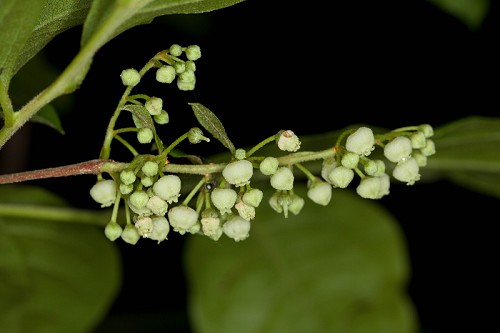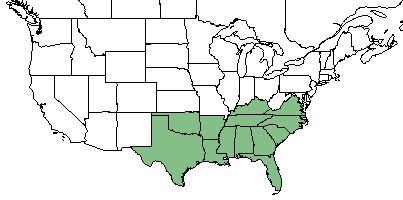Difference between revisions of "Lyonia ligustrina"
(→Ecology) |
HaleighJoM (talk | contribs) (→Ecology) |
||
| Line 44: | Line 44: | ||
Populations of ''Lyonia ligustrina'' have been known to persist through repeated annual burns.<ref>Platt, W.J., R. Carter, G. Nelson, W. Baker, S. Hermann, J. Kane, L. Anderson, M. Smith, K. Robertson. 2021. Unpublished species list of Wade Tract old-growth longleaf pine savanna, Thomasville, Georgia.</ref> | Populations of ''Lyonia ligustrina'' have been known to persist through repeated annual burns.<ref>Platt, W.J., R. Carter, G. Nelson, W. Baker, S. Hermann, J. Kane, L. Anderson, M. Smith, K. Robertson. 2021. Unpublished species list of Wade Tract old-growth longleaf pine savanna, Thomasville, Georgia.</ref> | ||
| − | ===Pollination | + | ===Pollination=== |
''Lyonia ligustrina'' is visited by ground-nesting bees from the Andrenidae family (''Andrena crataegi, A. kalmiae, A. mandibularis, A. nivalis, A. rufosignata'' and ''Perdita novaeangliae''), bees from the Apidae family (''Bombus citrinus, B. sandersoni, Epeolus ilicis, E. lanhami'' and ''Nomada cressonii''), plasterer bees from the Colletes family (''Colletes productus'' and ''Hylaeus sp.''), sweat bees from the Halictidae family (''Augochlorella aurata, Halictus rubicundus'' and ''Lasioglossum sp.'') and melittid bees from the Melittidae family (''Melitta melittoide'').<ref>Discoverlife.org [https://www.discoverlife.org/20/q?search=Bidens+albaDiscoverlife.org|Discoverlife.org]</ref> | ''Lyonia ligustrina'' is visited by ground-nesting bees from the Andrenidae family (''Andrena crataegi, A. kalmiae, A. mandibularis, A. nivalis, A. rufosignata'' and ''Perdita novaeangliae''), bees from the Apidae family (''Bombus citrinus, B. sandersoni, Epeolus ilicis, E. lanhami'' and ''Nomada cressonii''), plasterer bees from the Colletes family (''Colletes productus'' and ''Hylaeus sp.''), sweat bees from the Halictidae family (''Augochlorella aurata, Halictus rubicundus'' and ''Lasioglossum sp.'') and melittid bees from the Melittidae family (''Melitta melittoide'').<ref>Discoverlife.org [https://www.discoverlife.org/20/q?search=Bidens+albaDiscoverlife.org|Discoverlife.org]</ref> | ||
| + | <!--===Herbivory and toxicology===--> | ||
<!--==Diseases and parasites==--> | <!--==Diseases and parasites==--> | ||
Revision as of 19:08, 14 July 2022
Common name: Maleberry[1], He-huckleberry[2]
| Lyonia ligustrina | |
|---|---|

| |
| Photo by the Southeastern Flora Database | |
| Scientific classification | |
| Kingdom: | Plantae |
| Division: | Magnoliophyta - Flowering plants |
| Class: | Magnoliopsida - Dicots |
| Order: | Ericales |
| Family: | Ericaceae |
| Genus: | Lyonia |
| Species: | L. ligustrina |
| Binomial name | |
| Lyonia ligustrina L. | |

| |
| Natural range of Lyonia ligustrina from USDA NRCS Plants Database. | |
Contents
Taxonomic Notes
Synonyms: Arsenococcus frondosus (Pursh) Small; Xolisma foliosiflora (Michaux) Small; Xolisma ligustrina (Linnaeus) Britton.[3]
Varieties: Lyonia ligustrina (Linnaeus) A.P. de Candolle var. foliosiflora (Michaux) Fernald; Lyonia ligustrina (Linnaeus) A.P. de Candolle var. ligustrina.[3]
Description
L. ligustrina is a perennial shrub of the Ericaceae family native to North America.[1]
Distribution
L. ligustrina var. foliosiflora ranges from southeast Virginia to central Florida, west to eastern Texas and eastern Oklahoma, and north to Tennessee and Arizona. Var. foliosiflora is the usual variety on the Coastal Plain. Lyonia ligustrina var. ligustrina ranges from southern Maine, southern New Hampshire, southern Vermont, southeastern New York, southern Ohio, West Virginia, and Kentucky, south to west-central South Carolina, northern Georgia, and northeastern Alabama. Var. ligustrina is the usual variety in the Mountains and Piedmont, but also extends into the Coastal Plains of North Carolina and South Carolina.[3]
Ecology
Habitat
L. ligustrina is found in pocosins, seepage bogs, mountain bogs, shrub balds, bottomlands, other moist to wet habitats, and "dry" exposed ridges at high elevations.[2] Specimens have been collected from wet woodland along streams, swampy woodland, pine flatwoods, cypress swamp, and low wet savanna.[4]
L. ligustrina increased its presence in response to soil disturbance by heavy silviculture in North Carolina longleaf pinewoods. It has shown regrowth in reestablished longleaf pine sites that were disturbed by these practices.[5]
Phenology
L. ligustrina var. foliosiflora flowers from late April through June, and fruits from September through October. L. ligustrina var. ligustrina flowers from May through July and fruits from September through October.[3]
Fire ecology
Populations of Lyonia ligustrina have been known to persist through repeated annual burns.[6]
Pollination
Lyonia ligustrina is visited by ground-nesting bees from the Andrenidae family (Andrena crataegi, A. kalmiae, A. mandibularis, A. nivalis, A. rufosignata and Perdita novaeangliae), bees from the Apidae family (Bombus citrinus, B. sandersoni, Epeolus ilicis, E. lanhami and Nomada cressonii), plasterer bees from the Colletes family (Colletes productus and Hylaeus sp.), sweat bees from the Halictidae family (Augochlorella aurata, Halictus rubicundus and Lasioglossum sp.) and melittid bees from the Melittidae family (Melitta melittoide).[7]
Conservation, cultivation, and restoration
L. ligustrina is listed as possibly extirpated by the Ohio Department of Natural Resources Division of Natural Areas and Preserves.[1]
Cultural use
Photo Gallery
References and notes
- ↑ 1.0 1.1 1.2 USDA Plant Database https://plants.usda.gov/core/profile?symbol=LYLIF
- ↑ 2.0 2.1 Weakley, A. S. (2015). Flora of the Southern and Mid-Atlantic States. Chapel Hill, NC, University of North Carolina Herbarium.
- ↑ 3.0 3.1 3.2 3.3 Weakley, A.S. 2015. Flora of the southern and mid-atlantic states. Working Draft of 21 May 2015. University of North Carolina at Chapel Hill, Chapel Hill, North Carolina.
- ↑ URL: http://herbarium.bio.fsu.edu. Last accessed: June 2018. Collectors: R.K. Godfrey, Angus Gholson, Wilson Baker, Cecil Slaughter, S.W. Leonard, Robert Simmons, Jim Bickner, R.D. Houk, Elmer Prichard, Mary Margaret Williams, Sidney McDaniel, R.A. Norris, R. Komarek, William Platt. States and counties: Florida (Liberty, Hamilton, Volusia, Wakulla, Jefferson, Orange, Lake, Marion, Walton, Polk, Taylor, Leon, Duval, Osceola, Santa Rosa, Washington) Georgia (Thomas)
- ↑ Cohen, S., R. Braham, and F. Sanchez. (2004). Seed Bank Viability in Disturbed Longleaf Pine Sites. Restoration Ecology 12(4):503-515.
- ↑ Platt, W.J., R. Carter, G. Nelson, W. Baker, S. Hermann, J. Kane, L. Anderson, M. Smith, K. Robertson. 2021. Unpublished species list of Wade Tract old-growth longleaf pine savanna, Thomasville, Georgia.
- ↑ Discoverlife.org [1]